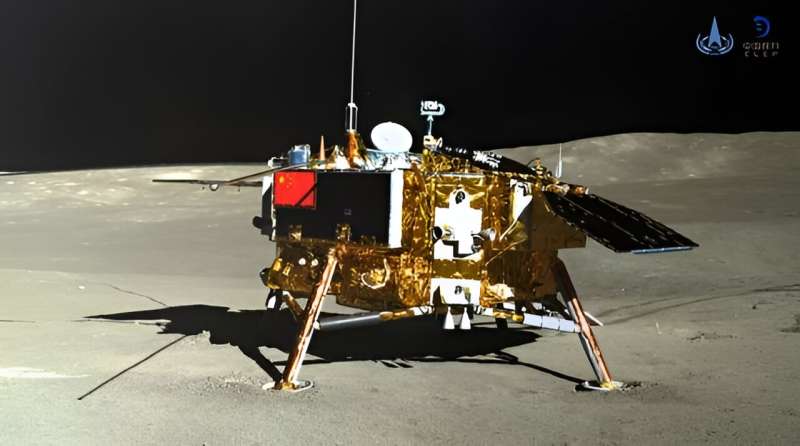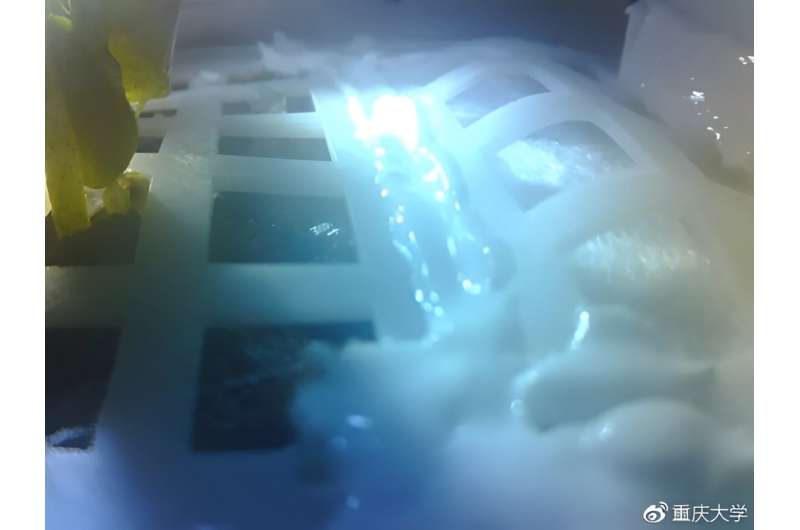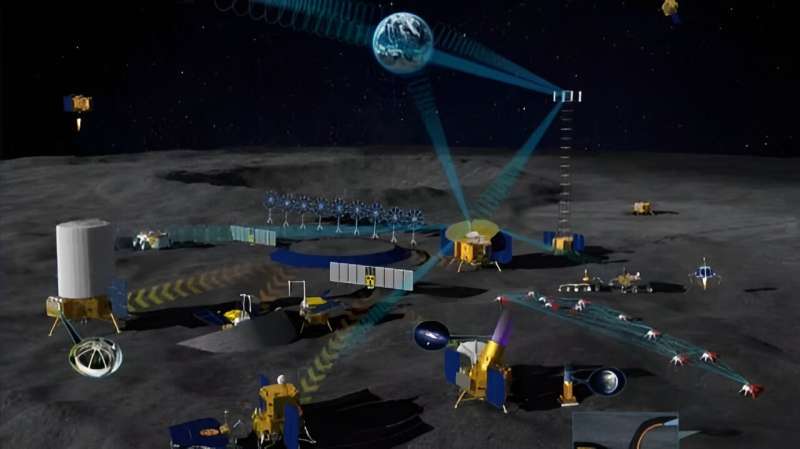This article has been reviewed according to Science X's editorial process and policies. Editors have highlighted the following attributes while ensuring the content's credibility:
fact-checked
peer-reviewed publication
trusted source
proofread
China set up a tiny farm on the moon in 2019. How did it do?

On January 3, 2019, China's Chang'e-4 lander touched down on the far side of the moon and deployed the Yutu rover. In addition to its many instruments, the rover carried an important science experiment known as the Biological Experiment Payload (BEP). Over the next eight days, this payload conducted a vital experiment where it attempted to grow the first plants on the moon. Included in the payload were cotton, potato, arabidopsis, and rape seeds, along with fly eggs, yeast, and 18 ml (0.6 fluid oz) of water, which was kept at a constant atmospheric pressure.
The results of this experiment will help inform future Bioregenerative Life Support System (BLSS), which will prove vital to habitats and missions beyond Low Earth Orbit (LEO). A team of scientists from China recently released a study that reviewed the experiment, its results, and its potential implications for future missions to the moon, Mars, and other deep-space locations. As they concluded, the experiment demonstrated that plants can grow on the moon despite the intense radiation, low gravity, and prolonged intense light.
The team consisted of researchers from the Center of Space Exploration, the College of Aerospace Engineering, and the Key Laboratory of Biology and Genetic Breeding for Tuber and Root Crops at Chongqing University, as well as the University of Electronic Science and Technology of China and the Laboratory of Space Biology at the Chinese Academy of Agricultural Sciences in Chengdu.
The results of their analyses were shared in two papers that appeared on June 20 in Microgravity Science and Technology and on October 17 in Acta Astronautica, respectively.
Growing plants in lunar, Martian, and space habitats is essential for many reasons. In addition to providing a source of nutrition and reducing the need for resupply missions, they will also remove carbon dioxide and provide fresh oxygen, help recycle waste, and contribute to the crews' sense of well-being. And whereas conventional Environmental Control and Life-Support Systems (ECLSS) rely on mechanical components that eventually break down and require replacement, a bioregenerative system can replenish itself over time.
This makes BLSS technology ideal for missions to deep space where opportunities to resupply will be few and far between. For years, astronauts have conducted experiments aboard the International Space Station (ISS) involving plant growth and algae—such as the Vegetable Production System (Veggie), the Passive Orbital Nutrient Delivery System (PONDS), the Advanced Plant Habitat (APH), and the Plant Habitat Avionics Real-time Manager (PHARM). However, it is still uncertain how the natural environment of extraterrestrial bodies will affect the function of a BLSS.
Lead author Xie Gengxin, a Professor of environmental engineering at the Center of Space Exploration, Chongqing University, is also the chief designer of the BEP. As he explained to Universe Today via email, the ability to cultivate plants in space is a necessary step toward establishing bases beyond Earth:
"When establishing a survival base on the moon, Mars, and other extraterrestrial planets, it is impossible to transport more things from the Earth. The need for in-situ use of resources for the production of oxygen and food is particularly important and is the first step to establishing a survival base, so plant planting experiments are very important."

The first biological experiment
The BEP payload, developed at Chongqing University, was the first biological experiment conducted by humans on the far side of the moon. The purpose of the experiment was to assess the effects of lunar surface conditions (low gravity, intense radiation, and intense light) on the growth and health of terrestrial organisms. The payload weighed 2.608 kg (5.75 lbs) and measured 198 mm in height and 173 mm in diameter (7.75 by 6.8 inches), offering a total volume of 0.82 liters and 0.42 liters of bio-activity space. Sunlight was admitted through a guide tube, allowing photosynthesis for the plants inside.
These six components constituted the producers, consumers, and decomposers, all the elements necessary for a functioning ecosystem. The plants were to produce oxygen and nutrients through photosynthesis and be sustained by the fruit flies. Meanwhile, the yeast would act as a decomposition agent, processing waste from the flies and dead plants to create additional nutrients for the ecosystem. As Xie said, this experiment was the first of its kind and was meant to address concerns scientists had about the lunar environment:
"Before our experiment, many scientists were worried that plants could not sprout under the intense light intensity and intense radiation conditions of the moon, so we deliberately used the natural sunlight on the moon for photosynthesis rather than artificial light. At the same time, our biological payloads were not designed to protect against radiation, proving that plants can still grow under the moon's intense radiation conditions."
Within a few hours of the lander reaching the surface, the biosphere's temperature was adjusted to 24°C (75.2°F), and the seeds were watered. On January 15th, it was reported that cottonseed, rapeseed, and potato seeds had sprouted, and images of the BEP's interior were released.
"There are animals, plants, and microorganisms in this payload, creating a micro-ecosystem in a closed environment," said Xie Gengxin at the time. "We guide the sunlight to the inside of the tin, which is much stronger than that on the Earth. We will study their photosynthesis under strong sunlight and compare it with the experiment on the Earth."

Results
On the following day, the experiment entered a new phase as lunar night set in, external temperatures dropped to -52°C (-62°F), and the experiment failed to maintain a comfortable temperature. As temperatures continued to drop, eventually reaching -190°C (-310°F), the experiment continued to test the longevity of the BEP. Eventually, it was reported that the sprouted plants had died, that the potatoes failed to sprout, and that the fruit flies failed to hatch. The total run time for the experiment was nine days instead of the planned 100. But as Xie indicated, valuable information was obtained. Said Xi:
"Although our plants can grow in the natural sunlight and radiation conditions of the moon, the safety of these plants has not been evaluated. Whether it is healthy or not needs further research. Our experiments also show how difficult it is to survive on the moon and how to survive the lunar night. Our first biological experiments on the moon for humankind fully demonstrate that a regenerative ecosystem can be built on the moon to establish a human base."
Looking ahead, Xie and his colleagues plan to conduct further experiments involving stable lava tubes, which China is also considering as a potential base site. "For the first time, we have sent six species from the Earth to the moon to conduct biological experiments, which has made an important milestone in establishing a base for human survival on the moon," he said. "Our team is now conducting research on how to establish a human base and space farm experiments by using lunar lava tube caves."
In less than two years, NASA plans to put astronauts on the moon for the first time since the Apollo Era. China hopes to do the same by sending the first taikonauts to the moon's southern polar region by 2030. The long-term aims of these and other agencies—like the ESA, Roscosmos, and the Indian Space Research Organization (ISRO)—are nothing short of establishing a permanent human outpost on the moon that will enable research, exploration, international cooperation, and missions to deep space. A key aspect of this will be using local resources to meet crews' needs.
One of the best ways of ensuring a steady supply of food, breathable air, and crew health (physical and mental) is to build habitats that can accommodate greenhouses and plant experiments. In short, astronauts must bring elements of Earth's biosphere with them to live, work, and thrive in extraterrestrial environments. The lessons of this research will help pave the way for anyone who intends to follow.
More information: Gengxin Xie et al, The Lunar One-Sixth Low Gravity Conduciveness to the Improvement of the Cold Resistance of Plants, Microgravity Science and Technology (2023). DOI: 10.1007/s12217-023-10058-9
GengXin Xie et al, The first biological experiment on lunar surface for Humankind: Device and results, Acta Astronautica (2023). DOI: 10.1016/j.actaastro.2023.10.023
Journal information: Acta Astronautica
Provided by Universe Today





















